
Pairing Astilbes
7 successful pairing ideas
Contents
Astilbes are beautiful perennials that produce (June-July) feathery spikes in white, pink, red, or mauve, perfect for bringing brightness to shaded corners of the garden. They also feature attractive, finely cut foliage, sometimes beautifully coloured (as seen in the varieties ‘Chocolate Shogun’, ‘Color Flash’, or ‘Beauty of Lisse’). The height of astilbes varies greatly: from 20 cm for the smallest varieties to 1.70 m for the tallest!
Astilbes thrive in partial shade, in heavy, moist soil, rich, fertile, neutral to slightly acidic. They prefer slightly acidic soils and require the soil to remain cool throughout the season. They are well-suited for enhancing the banks of a pond or marshy areas. Astilbes have good longevity, are resistant to diseases, and are quite hardy (down to -20 °C). Discover our finest ideas and inspirations for pairing them in the garden, according to your desires and garden style!
And to learn everything about their cultivation, feel free to check our sheet “Astilbe: Planting, Cultivation, Maintenance”
In a woodland garden
Astilbes thrive in shade or partial shade and are ideal for creating a woodland garden. Pair them with shade-loving plants that have generous foliage, such as hostas, ferns, and Hakonechloa. Also consider the beautiful bell-shaped flowering of foxgloves, perfect for adding brightness, and that of Iris foetidissima. The Aruncus dioicus ‘Sylvestris’ is a majestic perennial with dark green, finely cut foliage and white feathery inflorescences that will beautifully complement the leaves and flowers of astilbes! Also consider the common angelica, Angelica archangelica, a tall apiaceae that reaches heights of 1.5 to 2 metres and offers lovely spherical umbel inflorescences, very graphic in appearance. Think about the hydrangea Hydrangea aspera, which bears beautiful flat umbels in summer made up of small fertile mauve flowers and large sterile white flowers, slightly pinkish.

Astilbe japonica ‘Deutschland’, Digitalis grandiflora, Hydrangea aspera villosa, Iris foetidissima, and Dryopteris affinis, Angelica sylvestris
In a naturalistic, rural garden
With its very natural and light style, astilbe is perfect for creating a rustic, wild decor. You might choose Astilbe japonica ‘Red Sentinel’, with short, ramified panicles in scarlet red. To accompany it, select plants with airy, very flexible flowering. For this, nothing beats knauties, centauries, penstemons, and sanguisorbes! Consider the stunning flowering of Alliums, which have both a graphic and rustic style. Don’t forget to include some grasses, like the beautiful Stipa pulcherrima.
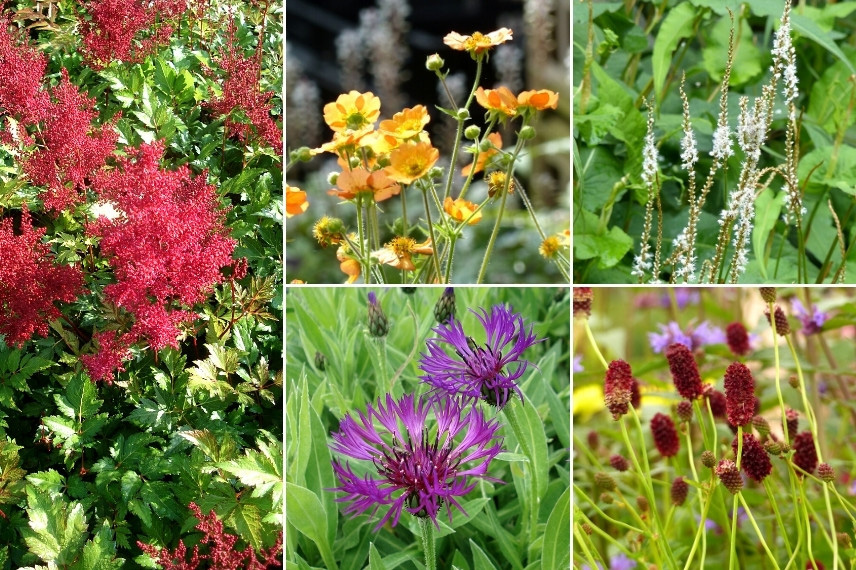
Astilbe japonica ‘Red Sentinel’, Geum ‘Totally Tangerine’, Persicaria amplexicaulis ‘Alba’, Centaurea montana ‘Violetta’, and Sanguisorba ‘Red Thunder’
Discover other Astilbe - False Goatsbeard
View all →Available in 1 sizes
Available in 1 sizes
Available in 0 sizes
Available in 3 sizes
Available in 3 sizes
Available in 2 sizes
Available in 1 sizes
Available in 1 sizes
Available in 1 sizes
Available in 3 sizes
To create a white garden
White gardens are incredible for their elegance. Very bright, they exude an impression of purity and lightness. Choose a variety of pure white flowering astilbe, for example, Astilbe japonica ‘Deutschland’. To accompany it, consider the immaculate flowering of Epilobium angustifolium ‘Album’, Allium ‘White Cloud’, and Campanula lactiflora ‘Alba’. As for shrubs, consider Deutzia setchuenensis ‘Corymbiflora’, which bears stunning star-shaped white flowers from June to September. You can also incorporate variegated foliage, such as that of Philadelphus coronarius ‘Variegatus’, Cornus controversa ‘Variegata’, and Pittosporum tenuifolium ‘Elisabeth’.
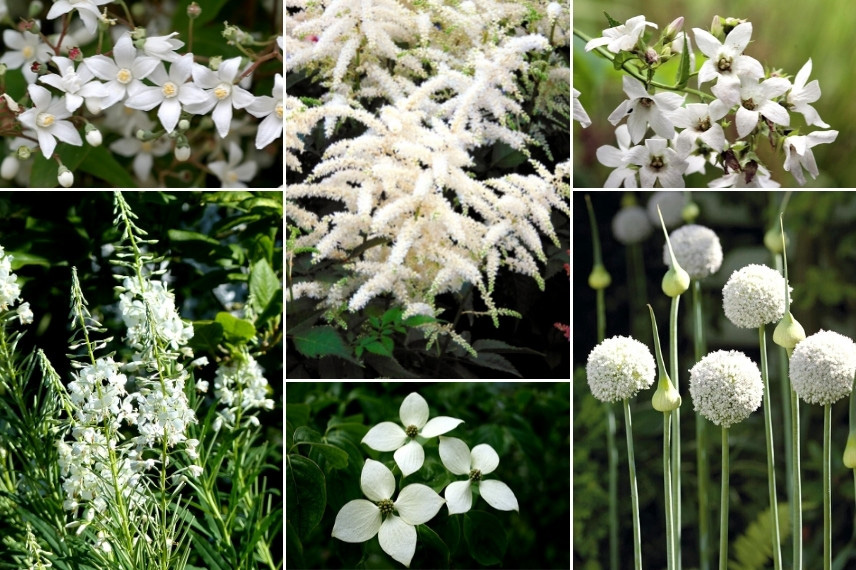
Deutzia setchuenensis ‘Corymbiflora’, Astilbe ‘Deutschland’, Campanula lactiflora ‘Alba’, Epilobium angustifolium ‘Album’, Cornus kousa ‘Chinensis’, and Allium ‘White Cloud’
Read also
Fluffy plantsIn a romantic garden
Enjoy astilbes to create a romantic garden: their light panicles easily create a tender and delicate atmosphere. Choose a variety with white or pink flowers (for example, Astilbe arendsii ‘Diamant’ or Astilbe japonica ‘Delft Lace’), and pair it with blooms in soft, pastel shades: white, pink, mauve… You might opt for the very delicate flowers of masterworts, clematis, gypsophila, and hardy geraniums. And of course, don’t forget the roses, the kings of romantic gardens! For example, choose the old rose ‘Red Ballerina’, which offers generous bouquets of simple carmine pink flowers with white centres. Also incorporate silver foliage, such as that of wormwoods, Stachys byzantina, Salvia argentea, or Senecio cineraria.
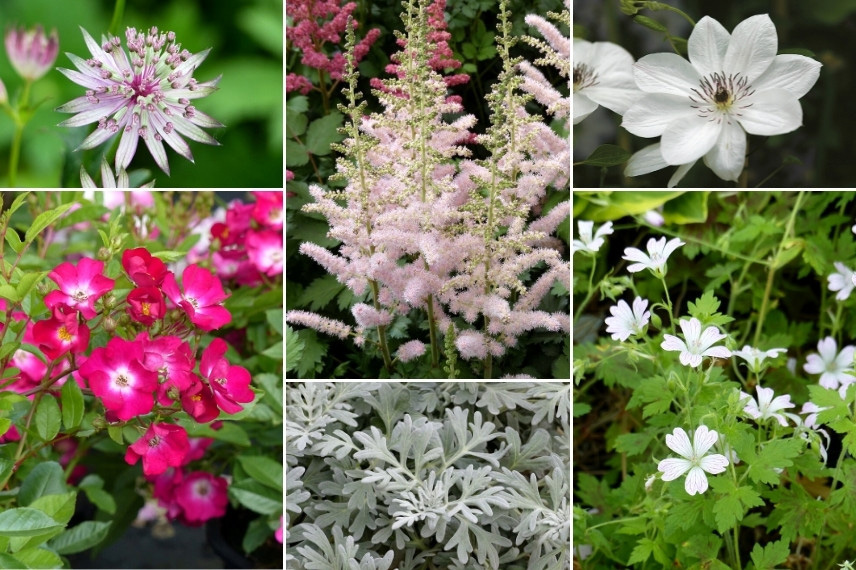
Astrantia major ‘Ruby Star’, Astilbe ‘Censation Glitter and Glamour’, Clematis ‘White Pearl’, Rose ‘Red Ballerina’, Artemisia stelleriana ‘Silver Brocade’, and Geranium oxonianum ‘Katherine Adele’
On the banks of a pond
Astilbes thrive in soils that remain cool to moist throughout the season, and will therefore be perfectly at home by the edge of a pond. They can create a very natural scene alongside Pontederia cordata, Thalia dealbata, and Meadowsweet (Filipendula ulmaria), which, like astilbe, offers a feathery flowering display. Enjoy the splendid white flowers with purple stamens of Anemone rivularis. Also consider ferns such as Matteuccia and Osmunda. Their beautifully divided foliage will create a lush and very natural atmosphere!
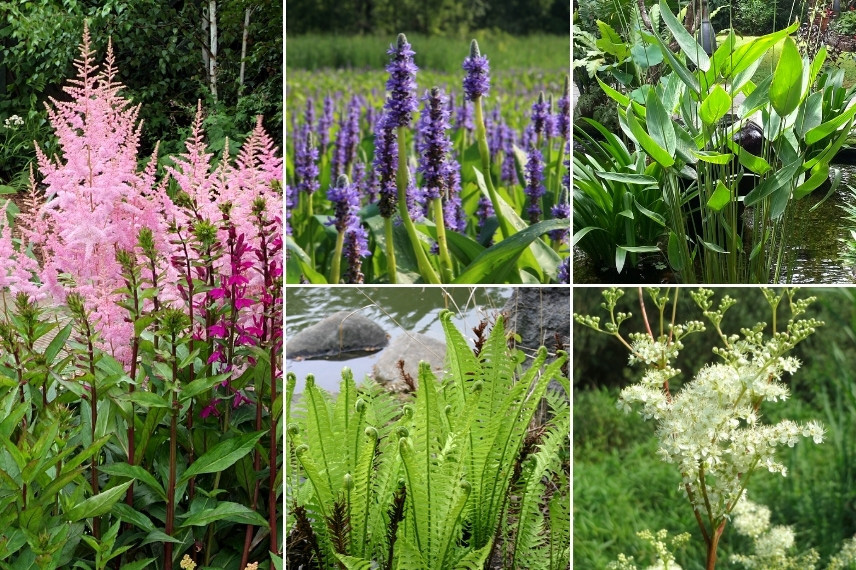
Astilbe arendsii ‘Catleya’ and Lobelia speciosa ‘Tania’ (copyright Flora Press – Nathalie Pasquel), Pontederia cordata, Thalia dealbata (photo Lip Kee), Matteuccia struthiopteris (photo Ryan Somma), Filipendula ulmaria (photo Andreas Rockstein)
For a garden full of sweetness!
Compose a very soft and comforting garden by combining feathery flowerings in white and soft pink tones, along with foliage that has a silky texture. In your choice of plants, favour soft, rounded shapes or delicate curves, and avoid sharp and rigid foliage, as well as flowers in bright and exciting shades like scarlet red, orange, or bright yellow. For example, plant Astilbe ‘Nikki’ alongside Sanguisorba obtusa, Thalictrum aquilegifolium, Cotinus coggygria, and Pennisetum orientale ‘Tall Tails’. Enjoy the large rounded inflorescences of Hydrangea ‘Sweet Annabelle’. For fluffy foliage, consider Stachys byzantina and Senecio ‘Angel Wings’.
For more ideas on this theme, discover our advice sheet on comfort plants, as well as our inspiration page: “Comfort Trend and Candy Floss”.
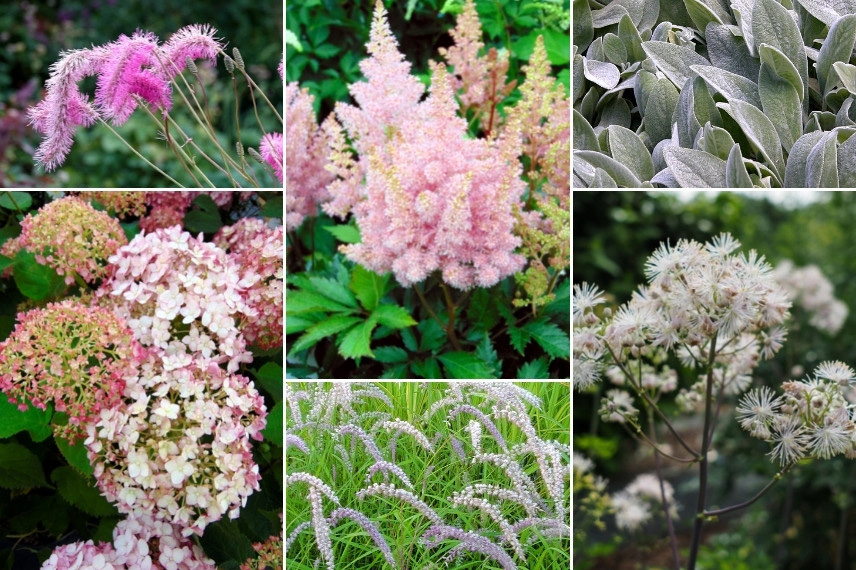
Sanguisorba obtusa, Astilbe ‘Nikki’, Stachys byzantina (photo Carl Lewis), Hydrangea arborescens ‘Sweet Annabelle’, Pennisetum orientale ‘Tall Tails’, and Thalictrum aquilegifolium
With colourful foliage
To create a colourful border from spring to autumn, focus on foliage (much more durable than flowering plants)! For example, integrate Astilbe ‘Chocolate Shogun’ alongside the dark foliage of Ophiopogon planiscapus ‘Nigrescens’, then create contrast with the bright foliage of Persicaria ‘Painter’s Palette’ and Hakonechloa macra ‘Aureola’. Bring in colour with heucheras: their foliage comes in an incredible range of shades! Consider heuchera ‘Vienna’, which has beautiful red leaves. Also discover Persicaria ‘Purple Fantasy’, and don’t hesitate to include hostas, which also offer a great diversity of shades and variegations.
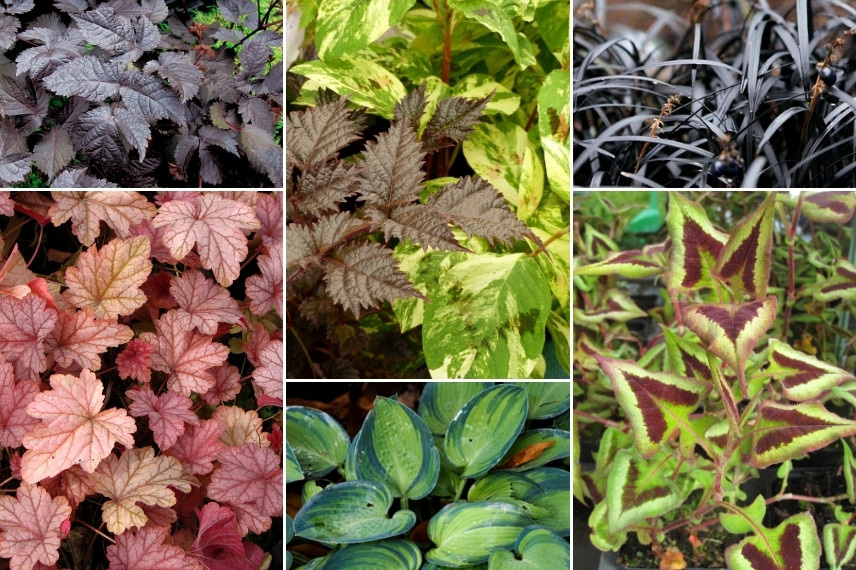
Astilbe ‘Chocolate Shogun’, Persicaria ‘Painter’s Palette’ and Astilbe ‘Chocolate Shogun’, Ophiopogon planiscapus ‘Nigrescens’ (photo brewbooks), Heuchera ‘Vienna’, Hosta ‘June’ and Persicaria ‘Purple Fantasy’
- Subscribe!
- Contents
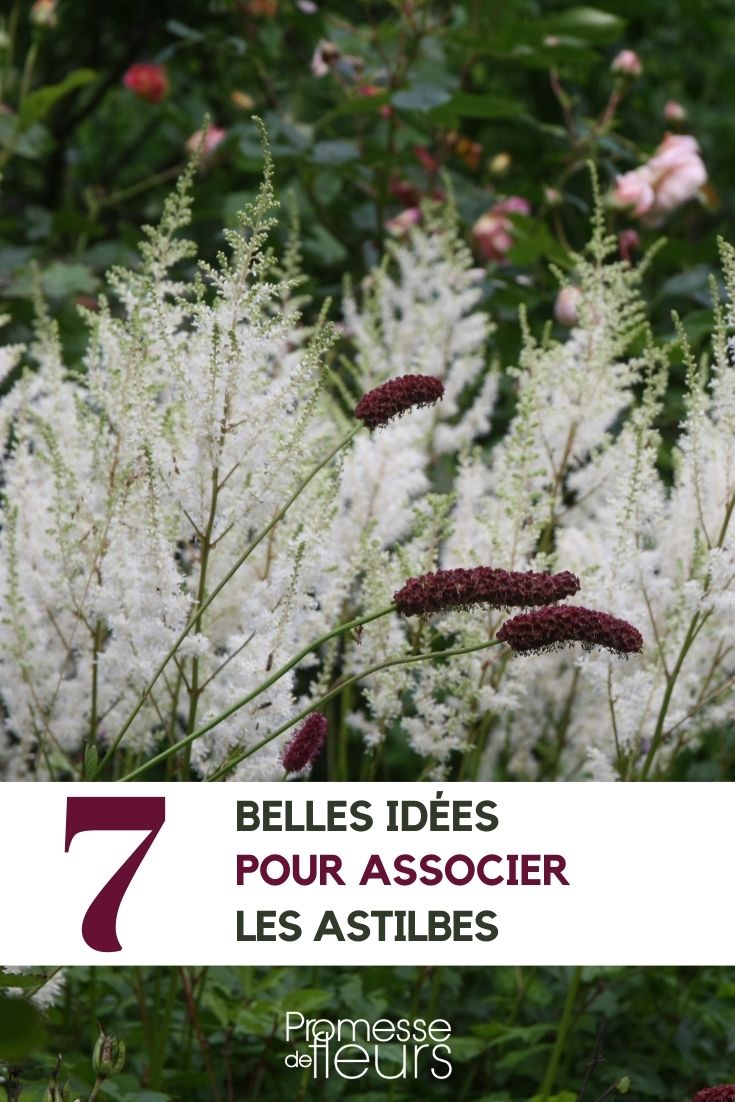

































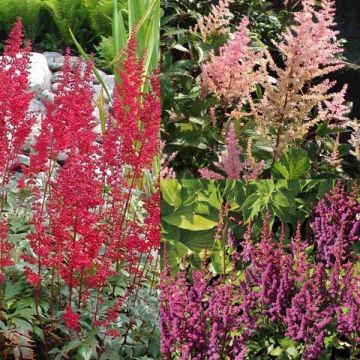
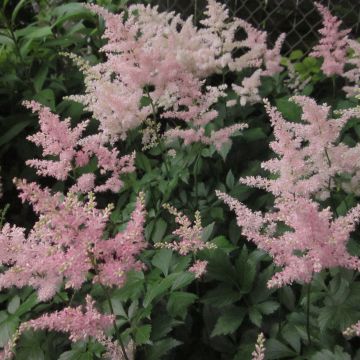

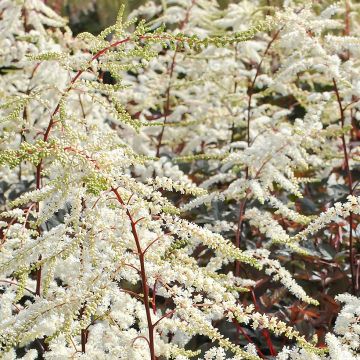

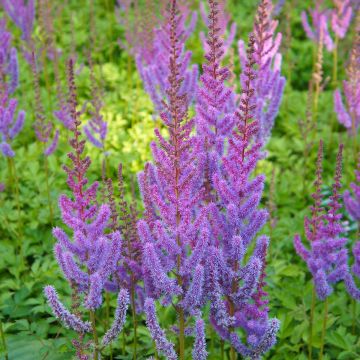
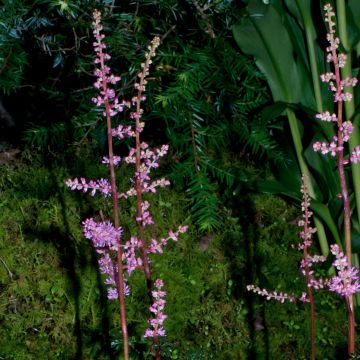

Comments